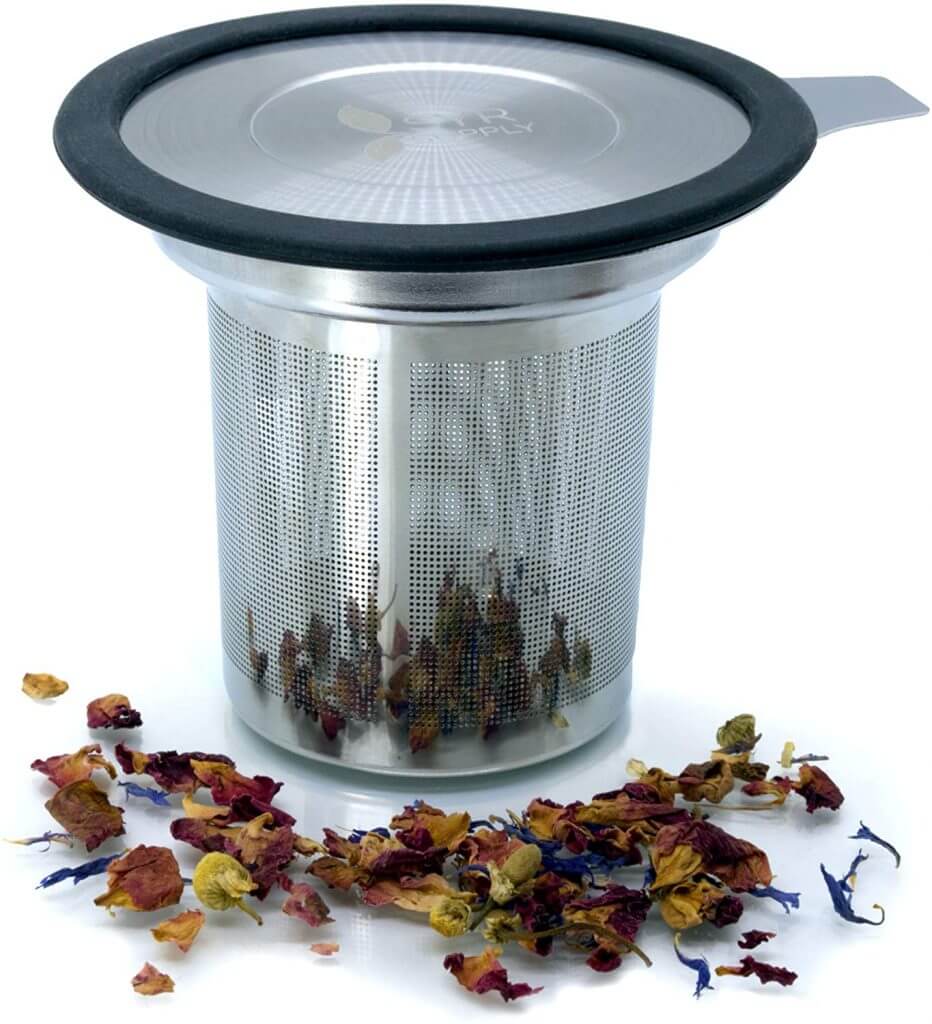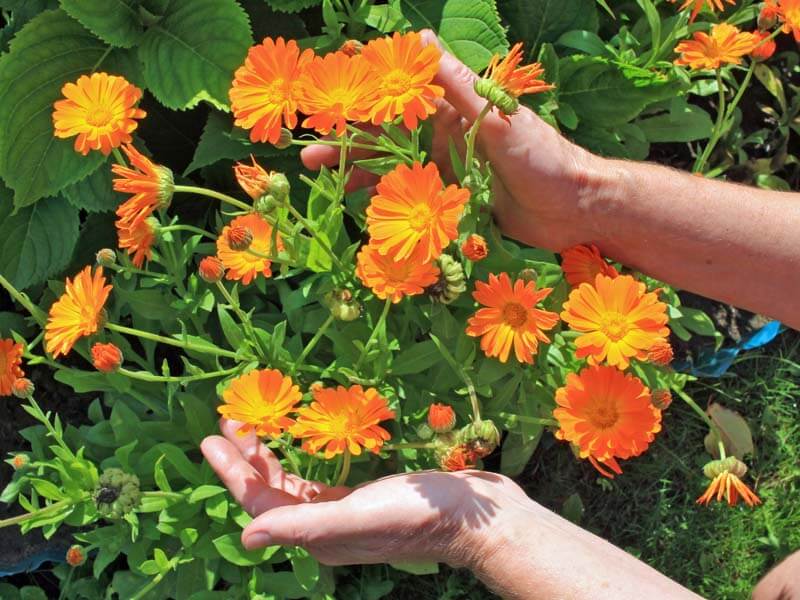Aside from COVID-19, it’s the season for colds, flu, and other bugs that bring us down in the chillier months. Despite social distancing, flu shots, good care, vitamins, and other attempts to ward them off, these bugs always arrive, unwelcome, and uninvited. So, how do you treat colds and flu naturally? DIY herbal remedies, of course! (Your favorite chicken soup recipe should be a close second.)
Healing Culinary Herbs

During the summer months, I grow plenty of herbs for teas, salves, soaps, and tinctures that I use in the winter. Some years I also grow medicinal herbs indoors on my sunny kitchen windowsill. They are inexpensive and effective, while also smelling pleasant and tasting good. Even nicer, some of the best grow like weeds, including peppermint, chamomile, garlic, cayenne pepper, lavender, and elderberry. Others, like ginger, are tender plants that can be grown indoors in winter or outdoors in summer. (Click here to learn more about growing ginger indoors.)
Anyone who has grown the classic herbs peppermint and chamomile knows that they’re wild and must be kept in bounds. Nonetheless, their usefulness far outweighs their weediness.
Pot Marigold

Pretty pot marigolds (Calendula officinalis) produce single or double daisies of orange or gold, and they thrive in cool weather. Their dried petals are used to make teas that are calming and ease the stomach. Combine them with other tea-making herbs that help with cold symptoms and congestion. Calendula is also used to make very effective creams to heal the skin. Let some of your calendula seedheads dry and sprinkle the seeds on the ground to sow themselves year after year.
Chamomile

Chamomile (Matricaria chamomilla) is a sun-loving herb that generally germinates in summer or fall, remains a low-growing foliage rosette through winter, and blooms in spring, producing a cloud of little white daisies. These choice flowers should be harvested at their prime and quickly dried to make herbal teas or inhalations. (Be cautious about letting them set seed; they can become weedy!)
Orange Chamomile Inhalant or Tea
A combination of dried orange peel and dried chamomile flowers makes a lovely tea or inhalant that will ease the stomach or gently clear the sinuses. Just add one teaspoon of dried or fresh orange peel and three tablespoons of dried chamomile flowers to two cups of boiling water. Steep it for 5 minutes, for tea, or place it in a heat-safe bowl and breathe it in after several minutes. Cover your head with a towel to keep the steam in.
Peppermint

Peppermint (Mentha x piperita) has rhizomatous roots that spread like wildfire, so I grow mine in large pots in sunny spots. The summer foliage and flowers are easily harvested and dried for year-round use. Peppermint can be used to make inhalations and compresses as well as head-clearing tea.
Peppery Peppermint Tea Recipe
A good, simple mint tea recipe for colds contains peppermint and a few other ingredients. For one pot fill your infuser with two teaspoons of dried elderberries, two tablespoons of dried peppermint leaves, and a few peppercorns or some cayenne flakes to fire up the spice. Fill your pot with boiling water, steep for 5 minutes, and serve with honey.
Garlic

Garlic has proven cold-fighting benefits and is truly a plant-it-and-leave-it crop requiring next to no care. Simply plant it in rich, well-drained soil in fall, and let it grow and bulb up in spring and summer. As any garlic grower can tell you, garden-fresh garlic is worlds more flavorful than the store stuff. Still, grocery garlic works just as well as a cold fighter.
Lemon Garlic Tonic
Fresh lemon-garlic tonic is a standby for cold sufferers. Simply add three large (or four small) sliced garlic cloves and the zest and juice of two lemons to three cups of boiling water in a saucepan. (Add some cayenne if your sinuses are troubling you.) Allow the mix to boil for 5 minutes before removing it from the heat and straining. Add a teaspoon of honey to each cup, and you’ll have a truly useful cold treatment.
Cayenne Pepper

Nothing clears the head and chest like something spicy. That’s why cayenne and other chilis (Capsicum annuum) are sought after as herbal remedies for cold sufferers. The sun- and heat-loving vegetable is easy as pie to grow during the summer months and just as easy to dry when red and ripe. Crushed cayenne can be added to any simple herbal tea as a stimulant to get the blood flowing. It is believed to help with headache pain and it clears stuffy sinuses.
Lavender

Lavender (Lavandula spp.) is one of the most beautiful, sun-loving plants, and its dried fragrant flowers and leaves are versatile herbs for health. Not only can they be added to soaps and creams, but they make wonderful cold inhalations.
Lavender Eucalyptus Inhalation
Infuse one tablespoon eucalyptus leaves and two tablespoons of lavender flowers into two cups of boiling water, steep for 5 minutes, and breath in under the cover of a towel. (Keep in mind that eucalyptus cannot be ingested, so do not drink this mix.) The two fragrant botanicals are harmonious partners. In fact, their oils may help to relieve depression, inflammation, and congestion, according to the U.S. National Institute of Health (NIH).
Elderberry
Gardeners with a good bit of space can and should grow elderberries (Sambucus spp.). Not only do they make delicious jam, jelly, and wine, they are also healthful and medicinal. The shrubs grow well in full sun or partial shade, though plants grown in more sun yield more fruits. Umbels of fragrant, yellowish spring flowers give way to dark, edible berries in late summer. Both the flowers and berries can be dried to make teas. The berries also make a delicious syrup that can be used to sweeten and flavor any herbal tea. All are believed to alleviate cough and allergy symptoms.
One warning: Elderberry seeds contain toxic chemicals (glycosides). There are two ways to make them safe. Avoid cracking elderberry seeds when drying them, or cook the fruits. They are rendered safe in the cooking process because the harmful chemicals are broken down.
Elderflower and Apple Tea
Fill your infuser with 2 tablespoons chopped, dried apples, and two tablespoons dried elderflower, and fill the pot with boiling water. Let it steep for 5 minutes and then sweeten with honey or sugar.
Ginger

Ginger root (Zingiber officinale) is delicious and desirable in more ways than one. Like cayenne, it’s spicy, so it acts as a stimulant that gets the blood flowing and clears the head and sinuses when added to tea or an infusion. It also helps soothe the stomach. Ginger is most easily grown in a pot outdoors in summer or in a sunny window or sunroom in winter. It’s plump, spicy roots can be harvested as needed.
Fresh Ginger & Cinnamon Tea
For delicious fresh ginger tea, boil five large slices of ginger root in three cups of water with a cinnamon stick for 10 minutes, strain, and serve with sugar or honey. (Click here to learn how to grow ginger.)
All of the plants mentioned grow best in soils with average to good fertility and excellent drainage. Before planting them in spring, amend the soil with Fafard Garden Manure Blend. Likewise, ginger plants grown indoors thrive when planted in Fafard Natural & Organic Potting Mix.
Two great reference books for medicinal herbal plants are The Modern Herbal Dispensatory by Thomas Easley and Steven Horne (2016), Grow It Heal It by Christopher Hobbs and Leslie Gardener (Rodale Books, 2013), and the classic Complete Medical Herbal by Penelope Ody (DK, 1993)
Though all of these herbal remedies are deemed safe by health experts, but it’s always smart to talk to your doctor before partaking in any herbal remedies. Also, be sure that you have no allergies to these plants before using them. Some planning ahead is required if you want to grow your own herbal remedies, but when the winter sniffles arrive, you will be glad you broke ground and took the time.



